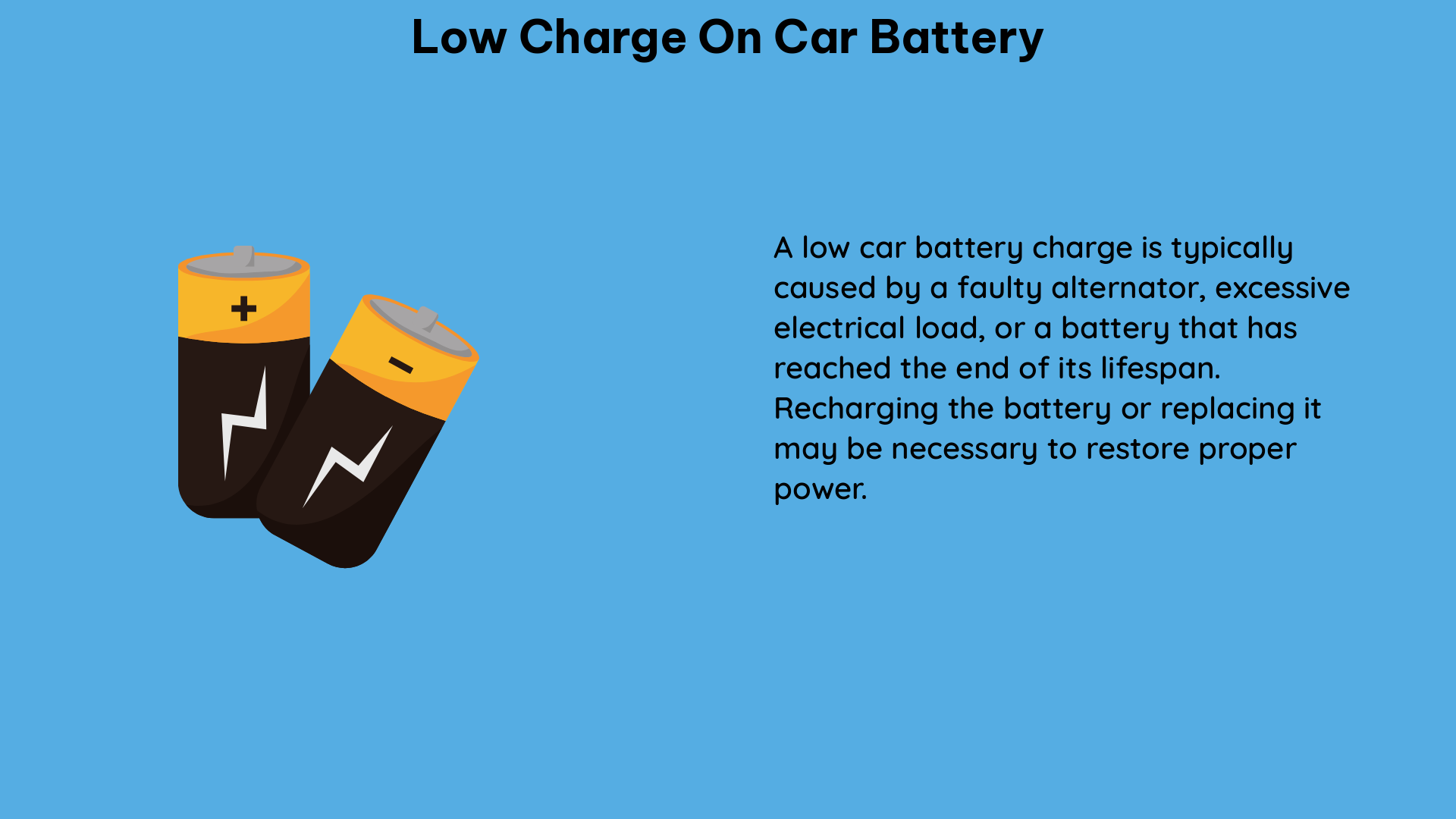A car battery’s charge level is a crucial factor in ensuring the smooth operation of your vehicle. A low charge can lead to a range of issues, from difficulty starting the engine to the failure of various electrical components. This comprehensive guide will delve into the intricacies of diagnosing and resolving low charge on car batteries, equipping you with the knowledge and tools to maintain your vehicle’s electrical system effectively.
Understanding Battery Charge Levels
The charge level of a car battery can be quantified in several ways, each providing valuable insights into the battery’s health and performance.
Voltage Measurements
A fully charged 12-volt car battery should read around 12.6 volts when measured with a digital multimeter (DMM). A discharged battery, on the other hand, may read as low as 11.8 volts. It’s important to note that temperature can affect the voltage reading, with a hot battery having a slightly higher voltage than a cold one.
Ampere-Hour (Ah) Ratings
The state of charge can also be measured in ampere-hours (Ah), which represents the battery’s capacity to store and deliver electrical energy. A fully charged battery will have a higher Ah rating than a discharged one. For example, a typical car battery may have a rating of 60-80 Ah when fully charged.
Specific Gravity Measurements
Another way to measure the state of charge is to use a battery hydrometer, which measures the specific gravity of the electrolyte in the battery. A fully charged battery should have a specific gravity of around 1.265, while a discharged battery may have a specific gravity of around 1.100.
Diagnosing Low Charge on Car Batteries

When a car battery is not holding a charge, there are several potential causes to consider. Understanding these factors can help you identify and address the root of the problem.
Battery Age and Condition
One of the primary reasons for a low charge on a car battery is its age and overall condition. As batteries age, their ability to hold a charge diminishes, and they may need to be replaced. Factors such as extreme temperatures, frequent deep discharges, and lack of maintenance can accelerate the aging process.
Sulfation
Deep discharges can cause sulfation, a condition where lead sulfate crystals form on the battery’s plates. This can reduce the battery’s ability to accept and hold a charge, leading to a low charge state. Addressing sulfation may require specialized charging techniques or even battery replacement.
Alternator and Charging System Issues
In some cases, the low charge on a car battery may be due to a problem with the alternator or the charging system. If the alternator is not providing the necessary voltage to keep the battery charged, or if there are issues with the wiring or other components in the charging system, the battery may not be able to maintain a full charge.
Preventing Low Charge on Car Batteries
To prevent a low charge on a car battery, it’s essential to implement a regular maintenance routine and adopt best practices for battery care.
Regular Battery Checks
Regularly checking the battery voltage and specific gravity can help you identify potential issues early on. This can be done using a digital multimeter and a battery hydrometer, respectively. Monitoring these metrics can provide valuable insights into the battery’s health and charge level.
Battery Cleaning and Maintenance
Keeping the battery terminals and connections clean and free of corrosion is crucial for maintaining a good charge. Use a wire brush or baking soda and water to clean the terminals, and apply a thin layer of battery terminal protector to prevent future corrosion.
Avoiding Deep Discharges
Minimizing deep discharges, such as leaving the headlights or other electrical components on for extended periods, can help prevent sulfation and prolong the battery’s lifespan. If a deep discharge does occur, it’s important to recharge the battery as soon as possible to prevent permanent damage.
Proper Charging and Storage
Ensuring that the battery is kept fully charged, either through regular driving or by using a smart battery charger, can help prevent sulfation and maintain the battery’s overall health. Additionally, proper storage, such as keeping the battery in a cool, dry place, can also contribute to its longevity.
Conclusion
A low charge on a car battery can be a frustrating and potentially dangerous issue, but with the right knowledge and tools, it can be effectively diagnosed and resolved. By understanding the various ways to measure battery charge levels, identifying the potential causes of low charge, and implementing a comprehensive maintenance routine, you can keep your car’s electrical system running smoothly and extend the life of your battery.
References:
- Detecting state of charge, auto battery, using DMM | All About Circuits
https://forum.allaboutcircuits.com/threads/detecting-state-of-charge-auto-battery-using-dmm.92311/ - Battery status indicator confusion? | Mechanics Stack Exchange
https://mechanics.stackexchange.com/questions/70037/battery-status-indicator-confusion - Car Battery Charge Level Issue – Physics Forums
https://www.physicsforums.com/threads/car-battery-charge-level-issue.1002466/ - Real-world study for the optimal charging of electric vehicles | ScienceDirect
https://www.sciencedirect.com/science/article/pii/S2352484719310911 - BU-804b: Sulfation and How to Prevent it – Battery University
https://batteryuniversity.com/article/bu-804b-sulfation-and-how-to-prevent-it

The lambdageeks.com Core SME Team is a group of experienced subject matter experts from diverse scientific and technical fields including Physics, Chemistry, Technology,Electronics & Electrical Engineering, Automotive, Mechanical Engineering. Our team collaborates to create high-quality, well-researched articles on a wide range of science and technology topics for the lambdageeks.com website.
All Our Senior SME are having more than 7 Years of experience in the respective fields . They are either Working Industry Professionals or assocaited With different Universities. Refer Our Authors Page to get to know About our Core SMEs.